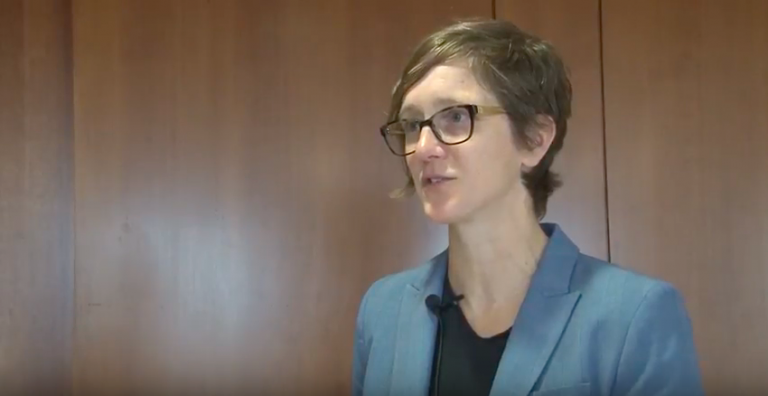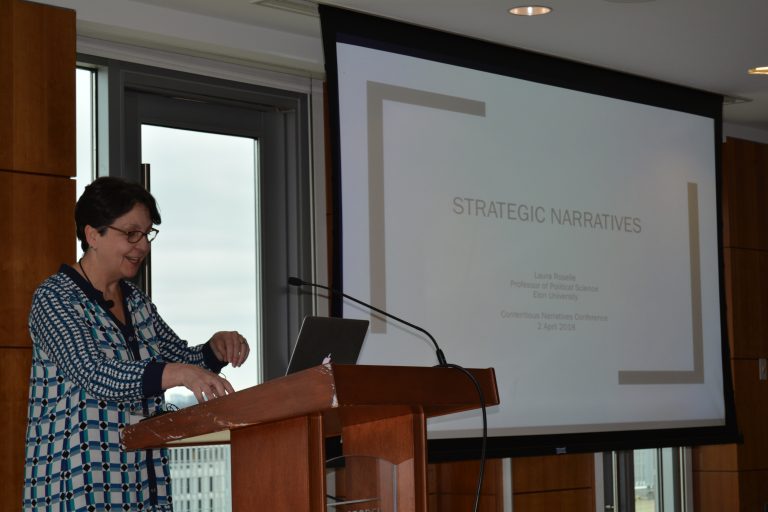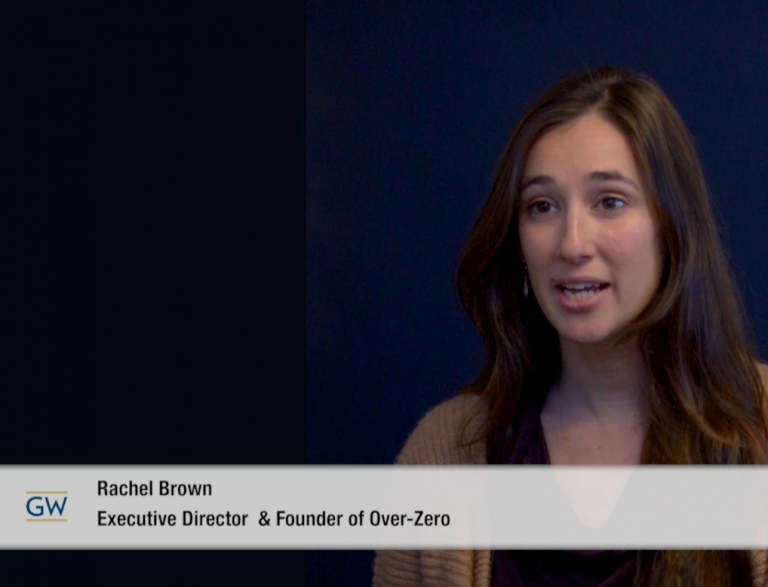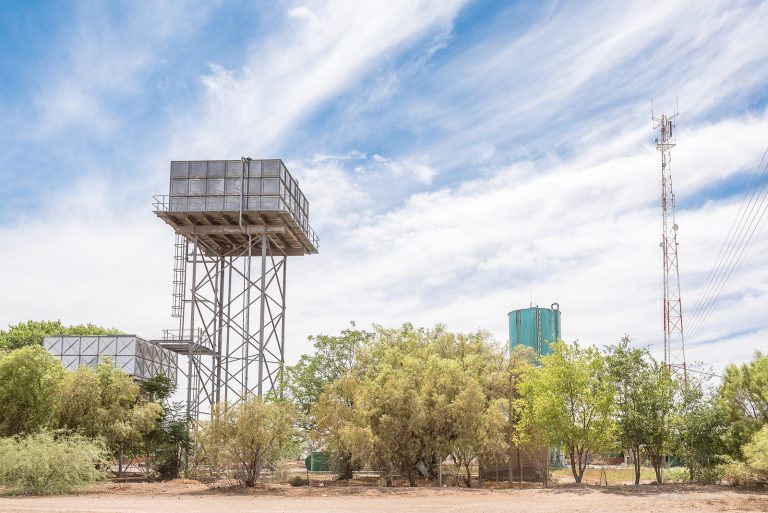Category: Online Hate and Offline Consequences
Strategic Narratives – Interview with Professor Laura Roselle
Strategic Narratives: Interview with Professor Laura Roselle
At the recent Contentious Narratives conference at GW's Elliot School of International Affairs, Professor Laura Roselle discussed her conception of 'strategic narratives' - the use of communicative tools by political actors to shape their roles in a rapidly changing world order.
The presence of new ICT technologies in developing nations is a similar phenomenon, in terms of its ability to present new narrative possibilites for both leaders and sub-groups within a state. In conflict-fragile states such as South Sudan, ethnic rivalries have been exacerbated by ICT enhancing group solidarity and amplfying perceived aggression or hostility from other groups - narrative arcs that can lead to bloodshed.
These same strategic narratives can also be used to reconcile divided societies. In Kenya, there have been successful cases of inter-ethnic cooperation following periods of violence, through ICT. Rather than encouraging division, these tools were used to crowdsource inter-group policing under the banner of a united Kenya.
The use of a strategic narrative can both hinder and encourage violence in these conflict-fragile states. Roselle's conception of these narrative arcs, and how they can come to define the consequences of political change, is vital to consider when examining the effects of ICT in the developing world.
Rachel Brown Interview
Boots on the Ground: Sisi ni Amani and the fight to prevent political violence in Kenya
Interview with Rachel Brown, director of Project Over Zero, former CEO of Sisi Ni Amini
As the executive director of Project Over Zero and former CEO of Sisi ni Amani, Rachel Brown has extensively examined the effects of mobile phones and related technologies on political violence. Rachel moved to Kenya in 2010 to research the causes of the country's frequently violent election process, revealing the extent to which cell phones were changing how violence was organized and how misinformation was spread. Local peacebuilders themselves were struggling to keep up, and needed their own tools to counteract the intensity and scope of these waves of violence that were being facilitated by technology. Sisi ni Amani was born as a result.
The organization approached the issues at hand with a ’10 steps ahead’ approach, owing to the speed at which misinformation, rumours and fear could circulate among communities. The initiatives used by Sisi ni Amani included: subscribing community members to messaging programs that could correct false information quickly; civic education programs over text message; invites to political debates and community meetings; and the promotion of radio programming that hosted civic engagement projects. These tools were designed to inhibit the potential for violence in the upcoming 2013 elections in Kenya.
Rachel remains ambivalent as to whether mobile phones and related technologies can themselves be blamed for the violence. Ultimately, she points out, human impulses will find a way to exercise themselves with or without cell phones. However she still emphasizes the ability these devices have to change how fast (mis)information can be spread, a new phenomenon that is changing how peacebuilders can effectively address the potential for political violence. Social media is certainly comparable in how it has transformed the information environment enough that peacebuilding efforts are required to adapt.
Project Over Zero, Rachel’s new organization, is particularly interested in addressing the issue of ‘dangerous speech’. The term ‘hate speech’ she likes to avoid, describing its implications of intent as limiting. These forms of speech are ones that police norms within communities; offer coded meanings that foreign observers can often fail to pick up on; and are capable of organizing groups of people with relative ease. The dehumanization of certain groups is the most prominent form of dangerous speech that Rachel emphasizes.
These forms of speech look different from community to community, but often share general themes that make the study of dangerous speech applicable here in the US. The importance of identity in both exacerbating and inhibiting violent action is a common thread among many communities, and this observation can be used by peacebuilders as well – both at home and abroad.
Sheldon Himelfarb, CEO of PeaceTech Lab: Interview
The Technological Future of Peacebuilding
PeaceTechLab, an independent nonprofit, conducts pioneering work to utilize technology in building peace around the globe. President and CEO Sheldon Himelfarb offers his thoughts on the most groundbreaking aspects of the organization and where peacebuilding technologies are having the greatest effect.
Q: How was PeaceTechLab first formed - how did it get off the ground and what was the initial impetus for its formation?
A: PeaceTechLab was spun out by the US Institute of Peace, which has long recognized the importance of and participated in media and technology initiatives with peacebuilding goals. Over its 30 years, USIP has been trying to drive forward the expansion and innovation of technology’s capacity for peacebuilding, as it allows a peacebuilder to reach so many more people than other peacebuilding techniques, such as training or negotiations.
Additionally, there was recognition around three years ago that technology was inflecting everyone’s work in this field to a greater extent than ever before. There wasn’t a single problem being worked on at USIP - whether it was preventing election violence, corruption, gender violence or resource scarcity and so on – that wasn’t being touched by technological developments. As a result, the USIP wanted to ‘double down’ on how to amplify technology for peacebuilding above the potentiality for technology to do harm.
The core concept of the Lab is to enable new partnerships with the private sector as well as innovative financing strategies that are traditionally difficult to do as a government body. The PeaceTechLab as an independent NGO has more latitude in these areas.
Q: Could you briefly highlight the most significant projects currently being undertaken at PeaceTechLab, and the ones you personally are most excited about.
A: PeaceTech Exchanges, which involves entering conflict areas – Iraq, Afghanistan, Myanmar – and working with local civil society organizations that are seeking to promote reconciliation over conflict and greater government accountability. The idea here is to introduce existing civil society organizations, already doing great work, to new tools that help them do more, do it better and do it faster. Local technology organizations assist us with this, because they understand what is available and how best to use it in this environment. By the end of this year, PeaceTech Exchanges will have been undertaken in 15 different countries.
When we are out in conflict zones, working with different partners, we are able to identify promising uses for tech in peacebuilding. In partnership with organizations such as Amazon Web Services and C5 Accelerate, we have built a peace tech accelerator where we bring the most promising ideas in peace tech to Washington. There we work with the startups to provide them with the support necessary to succeed -- from training on how to build a leadership team, how to construct and execute on a business plan all the way to getting these peacetech initiatives in front of the right investors who can support their work.
Also never underestimate how significant data is for peacebuilding today. We’ve invested in a project called groundTruth Global, which aggregates data from social media, sensors, satellites, data and from all kinds of other sources and then uses analytics to understand how to leverage this treasure trove for new early warning insights on social and economic disruption in conflict zones. groundTruth Global is truly state of the art in the way that it leverages machine learning, multi-lingual processing, artificial intelligence and other tools.
Our collaboration with Drexel University’s College of Engineering has also acted as a major partnership initiative for PeaceTech Lab. We work with them to modify USIP’s peacebuilding and conflict analysis curriculum and adapt it. These courses are ultimately at the core of Drexel’s bold initiative to offer the nation’s first master’s degree in ‘Peace Engineering’. We need more people with technical skills in this field, not just the social scientists who understand conflict -- and this is one way to get it.
Q: One of the most significant projects undertaken by PeaceTechLab was in South Sudan in 2013 and countering hate speech. Could you summarize the methodology used in this project? How is hate speech identified?
A: Hate speech is not new – it’s been around for as long as conflict has been around. It has taken a turn for the worse in South Sudan through ICT technologies allowing hate speech to take place at a greater speed and volume than before. This can’t just be taken on with alternative messaging; more foundational work needs to take place.
The project we undertook involved working with local partners to aggregate examples of hate speech and develop a robust lexicon to identify it. This was then used to train on the ground partners and tailor existing tools to identify hate speech, which often operated in coded language. We also conducted analysis to correlate the use of hate speech and actual violence that took place, to draw a line leading from one to the other that was not anecdotal.
Q: There is a significant body of research that suggests greater access to ICT technologies in conflict zones has in some cases exacerbated violence. Do you agree with this assessment? What are the best ways to mitigate against this possibility?
A: I’m familiar with some of the research you’re referring to, and there’s no question that technology is a tool that can be used for evil as well as good. I’ve also seen really compelling research showing that high penetration of ICT in societies is an important component of a culture of free expression and transparency that exposes corruption on bad governance.
There is no single narrative that technology is either spurring on conflict or helping to prevent it. What is clear, however, is that we have to do a lot more investment in amplifying the tools at hand that are able to build peace.
Sheldon Himelfarb is the CEO of PeaceTech Lab and a former foreign policy advisor to a member of the Senate Foreign Relations Committee. He was previously the CEO of Common Ground Productions and has managed multiple peacekeeping programs in warzones in Bosnia, Iraq, Angola, Libya and Macedonia.
Peacekeeping and Africa’s Evolving Infosystems
Peacekeeping and Africa's Evolving Infosystems
By Steven Livingston
In 2011, The Africa Center for Strategic Studies commissioned a research report to determine the spread of ICT technologies across Africa and subsequent effects on peacebuilding efforts. Professor Steve Livingston offers further insights into his research and policy recommendations.
A policy piece such as this one is not generally associated with any conceptual breakthroughs. But I think that the clearest breakthrough came in the form of two separate conclusions we came to through weeks of on-the-ground work in Africa.
The original purpose of the trip was to address issues related to African conventional legacy press. The Africa Center wanted to look at radio, tv etc. and ask whether it was supporting or undermining peace efforts. For example, these organizations have a history of being involved in hate speech, and most famously contributed to the genocide in Rwanda in 1994.
Going into the project, almost immediately, it became apparent the most important development occurring was the burgeoning use of mobile telephony. These are technologies and networks that most in the global north don’t even know exist and certainly don’t study. These are not smart phones but simpler technologies, using systems such as ‘Frontline SMS’, which is a way of aggregating text messages, both receiving them en masse and sending them out en mass.
Frontline SMS, among others, is used to facilitate collective action. For example, in the Kivu region of Eastern Congo, a conflict zone where state and military forces are not present, low-wattage radio stations and basic cell phones are used to create a low-tech security zone. Users will send a text message to a radio station that may be using Frontline SMS as an interface. The message will consist of simple announcements – deaths, births – but can also contain notifications or warnings e.g. an approaching force from the Lord’s Resistance Army, heading in a particular direction.
These texts would then be broadcasted as a community bulletin board service by the radio station, and encourage a wider region to take precautions. Cell phones in places like central Africa are able to facilitate community projects that would not be feasible in the absence of cell phones, low-wattage radio stations and technologies such as Frontline SMS. Brought together, you are facilitating a greater degree of security for vulnerable communities in remote regions.
On the potential for Cell Phones to act as Catalysts for Political and Ethnic Violence
The real problem here is collective action being misused, not the technology. A concept to consider here is ‘affordance’, and by that I mean the ability for something to afford a use. A technology that produces a range of potential uses inevitably results in it being applied to do all kinds of things. That digital connection can be used to warn a village of a marauding band of guerrillas, to allow for the transfer of money, or, unfortunately, for more nefarious ends.
Studies that have determined cell phones and related technologies to be encouraging violence are flawed. These researchers are often numbers-driven. 'Large-N' data sets often provoke pessimistic conclusions about why violence is occurring more generally, while those who do case studies tend to have much more upbeat assessments. The propensity to use large-N data sets leads to spurious correlations that only appear to be there.
A mobile phone can produce any kind of outcome, including coordinating violent actions. The kind of outcome that is produced has to do with the intentionality of the people using it. This can be distributing mosquito nets and preventing malaria; or, it can be used to coordinate violence.
What is wrong with this hypothesis is that the researchers are finding that as the usage of mobile phones increases in a region, the reported number of violent incidences is also rising. This is an information paradox.
Firstly, the mere awareness of a norm that one should not do something (like an act of violence) will obviously result in a spike of those incidences being reported. This correlation fails to consider this feature. Increased levels of education, the availability of media, these things lead to greater sensitivity that being subject to violence by a band of attackers is not normal or acceptable. Secondly, the availability of a cell phone is creating opportunities to report violence. A colleague of mine in Nairobi described to me his one thousand contacts on his cell phone, the vast majority located in remote villages across the region. They regularly text him and send him information, information that would be hidden to anybody outside of these communities before the advent of cell phones.
The cell phones have not caused these events, it is provoking awareness of these events in the first place. Its not the number of violent events that has changed, but the sensitivity to, and the instruments used to measure the events, that has changed.
Professor Livingston is a professor of Media and Public Affairs and International Affairs at George Washington University.





